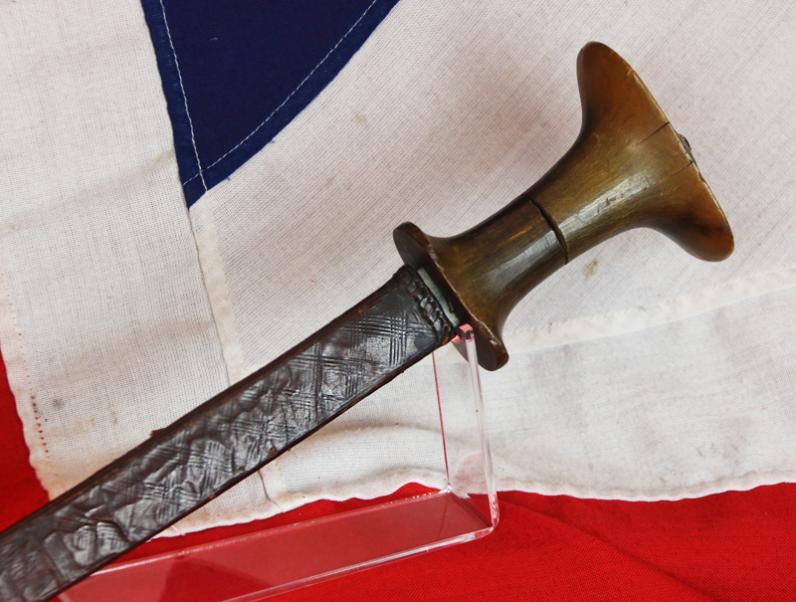⚔️Original 19th Century Carved Blonde Rhino Horn Hilted Emperor Menelik IInd Ethiopian Shotel With Deeply Curved Fully Etched Blade With Scrolling, Amharic Script & a 1780 Silver Austro Hungarian Thaler Pommel. & Used Into Reign of Emperor Haile Selassie
Bearing an exotic carved rhino horn hilt, of with fine blonde colouration, indicates this was the sword of the highest rank within the guard of the last Ethiopian Emperors.
Curved blade fully etched in its tooled brown leather scabbard. These very unusual swords with very curved blades come from the "Horn of Africa," which includes Abyssinia, which we now know as Ethiopia. Made famous just before WWII by the Italian Invasion of that Country, and the appeal by it's Emperor Haile Selassie to the League of Nations, which the Western Powers basically ignored. It's Capital is Addis Ababa, a city dating back some 2,000 years and more. A country much in the news but also a land largely still in the middle ages in some respects.
The sword, oft described as a shotel but actually it is a gorade, with its very characteristic curved blade. The swords dates back to the reign of Amda Seyon the 1st, known as "the Pillar of Zion" who was Emperor from 1314 - 1344. Called shotel, while technically the proper term locally for sabre was 'gorade'. Shotel which is not an Amharic word, Amharic for sword is gorade .The blade is etched with the profile of Emperor Menelik II, and also the symbol of the emperor, the Lion of Judah. The rest of the blade is etched with fancy scrolls. Menelik II baptised as Sahle Maryam (17 August 1844 – 12 December 1913) was Emperor of Ethiopia from 1889 to his death in 1913 and King of Shewa from 1866 to 1889. At the height of his internal power and external prestige, the process of territorial expansion and creation of the modern empire-state was completed by 1898. He is widely honoured by many Ethiopians and commemorated during the celebration of the Battle of Adwa, which is celebrated on March 1 or 2 across Ethiopia and in the diaspora. Many Pan-Africans regard him as an advocate for African independence against European powers during the Scramble for Africa.
Emperor Haile Selassie was one of the most famous leaders in Ethiopian history. As the emperor, he was exiled during the Italian occupation of Ethiopia due to the status he held. Selassie would go onto return to Ethiopia and help in taking back control of the country from Italy. On April 2, 1930, Ras Tafari Makonnen became Emperor Haile Selassie. Selassie was the last reigning monarch of Ethiopia’s Solomonic Dynasty. The Solomonic Dynasty traces its ancient ancestry to King Solomon of Israel and the Queen of Sheba, biblical figures who may have lived during the 10th century BCE.
Ethiopia is often acknowledged as the only nation in Africa never to have been colonized, and Selassie emerged as a powerful international figure as other African countries sought independence in the 20th century. His long reign and enduring policies (such as support for African unity and the abolition of slavery in Ethiopia) earned him a privileged position at international summits. For instance, Selassie was one of the highest-ranking diplomats at the funeral of U.S. President John Kennedy.
Emperor Selassie’s greatest impact may have been on the island of Jamaica. Jamaican religious leaders adopted a version of his birth name, Tafari (Ras was an official title) and Rastafarians regard Selassie as a god. (Selassie himself remained a Christian throughout his life.). Photo in the gallery of Emperor Hallie Selassie in full dress uniform. The Maria Theresa taler is a silver bullion coin and a type of Conventionstaler, first minted in 1741. The official weight is 28.0668 grams (0.99003 oz) and contains 23.386 grams (0.752 troy ounces) of fine silver. It has a silver content of .833 and a copper content of .166 of its total millesimal fineness. In 1751 this new standard Conventionstaler was effectively adopted across the German-speaking world when it was accepted formally in the Bavarian monetary convention. This new, post-1751 thaler has continued as a trade coin ever since. The last year of minting was in 1780, the year in which Maria Theresia died. As this coin type was very popular they continued the production, always been dated 1780. The Maria Theresia taler quickly became a standard trade coin and several nations began striking Maria Theresa talers. The following mints have struck Maria Theresia talers: Birmingham, Bombay, Brussels, London, Paris, Rome and Utrecht, in addition to the Habsburg mints in Günzburg, Hall, Karlsburg, Kremnica, Milan, Venice Prague, and Vienna. The Maria Theresa talers could also be found throughout the Arab world, especially in Saudi Arabia, Yemen, and Muscat and Oman, in Africa, especially in Somalia, Ethiopia, Kenya.
Overall in very nice condition, small edge nibbling to the hilt.
Code: 23600
1950.00 GBP










